#native bee
Photo


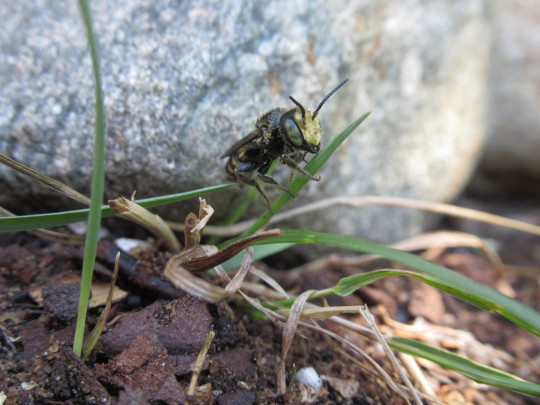

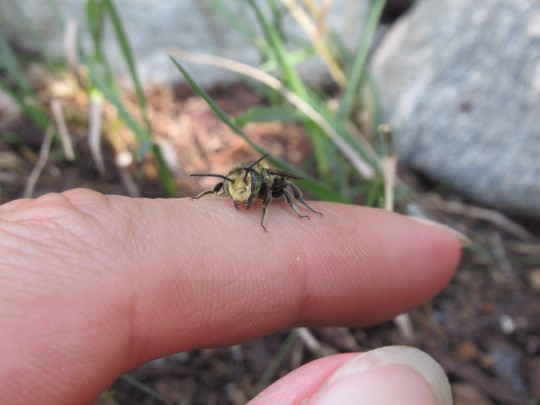

Photo dump of a [very fing adorable] leafcutter bee, possibly a male Megachile rotundata, pulled from our swimming pool yesterday. I tried to herd it towards some grass in bright shade, but he insisted on climbing on my hand until dry enough to fly away
#bees#insects#entomology#armchair non-expert#pollinators#native bee#alfalfa leafcutter bee#megachile rotundata#save the bees#leafcutter bee#cute animals#animal rescue#pollinator garden
19 notes
·
View notes
Text

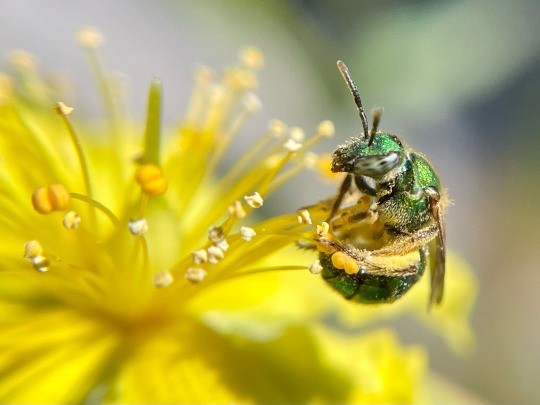
Sweat bee 💦 🐝
#bee#metallic sweat bee#sweat bee#bugblr#native bee#macro photography#my photos#nature#nature photography
12 notes
·
View notes
Text

Rosa cv. with native bee
08-JAN-2023
Melbourne, Vic
#australia#victoria#melbourne#flower#white#white flower#rose#white rose#rosids#rosales#rosaceae#rosoideae#roseae#rosa#australian natives#native fauna#native bee#insect#arthropod#bug#invertebrates#arthropoda#insecta#hymenoptera#apidae
0 notes
Text
https://www.xerces.org/blog/want-to-save-bees-focus-on-habitat-not-honey-bees
Five reasons why honey bees can be a problem
Native plants need native bees. Native bees coevolved with our native plants and often have behavioral adaptations that make them better pollinators than honey bees. For example, buzz-pollination, in which a bee grasps a flower and shakes the pollen loose, is a behavior at which bumble bees and other large-bodied native bees excel, and one that honey bees lack.
Honey bees are sub-par pollinators. The way that honey bees interact with flowers means that they sometimes contribute little or nothing to pollination. Honey bees groom their pollen and carry it in neat pollen cakes, where it’s less likely to contact the stigma of another flower and pollinate it. They are also known “nectar robbers” of many plants, accessing their nectar in a way that means they don’t touch the pollen, often by biting a hole in the base of the flower. By contrast, many of our native bees tend to be messier, carrying pollen as dry grains, often all over their bodies where it’s more likely to pollinate the plant.
Hungry hives crowd out native pollinators. Introducing a single honey bee hive means 15,000 to 50,000 additional mouths to feed in an area that may already lack sufficient flowering resources. This increases competition with our native bees and raises the energy costs of foraging, which can be significant. One study calculated that over a period of three months, a single hive collects as much pollen as could support the development of 100,000 native solitary bees!
Honey bees can spread disease. Unfortunately, honey bees can spread diseases to our native bees—deformed wing virus, for example, can be passed from honey bees to bumble bees—and can also amplify and distribute diseases within a bee community.
Urban honey bee hive densities are often too high. There is growing evidence of negative impacts in towns and cities from the presence of honey bees. A recent study from Montreal showed that the number of species of native bees found in an area decreased when the number of honey bees went up. In Britain, the London Beekeepers Association found that some parts of that city had four times as many hives as the city’s gardens and parks could support. The conservation organization Buglife recommends creating two hectares (five acres) of habitat for each hive, several times the size of an average residential lot in the United States.
1K notes
·
View notes
Text
Native Plant Info Masterlist...2!
This will be a USA centric post sadly, mostly focused on the East, since I am unfamiliar with resources outside of my area.
iNaturalist lets you upload pictures of any organisms and get them identified by the community, but if you don't want to upload, you can still lurk and look through all the photos being posted in your area to develop familiarity with the plants
Wildflower Search lets you toggle between photos of leaves, flowers, fruits etc. of each plant, gives loads of links to other sites that provide info, lets you search by flower color, plant type, time of year, and about a dozen other search criteria- very cool site
Wildflower.org is another very good site- has a search function where you can search plants by various traits and qualities
Find native plants by the number of butterflies that use them
Butterfly host plant list
Keystone species for every USA ecoregion for butterflies and bees
UNC Chapel Hill's 2022 Flora of the Southeastern United States. The ultimate EXHAUSTIVE compendium of plants. You can download it but beware it is over 2,000 pages long
Illinois Wildflowers is an excellent resource for plants found throughout the southeast and Midwest
Virginia Wildflowers
Northern Forest Atlas Awesome high quality photos of trees and leaves, buds, etc.
Name That Plant is a great resource focused on the Carolinas and Georgia
Maryland Biodiversity has much information on plants and many other creatures
Sarracenia.com is all about carnivorous plants
Native Beeology is focused on native bees of New York State
Also try looking up "[your state] native plant society" as many states have one! It could be a great way to find opportunities to get involved.
#usa centric#native plants#native plant gardening#gardening#plants#nature#flowers#bees#save the bees#no lawns#kill your lawn#fuck lawns#biodiversity#conservation#us centric#trees
2K notes
·
View notes
Text
If you're in the U.S. and want to support local plants and pollinators, I hope you've heard of the Xerces Society. Weird name, but super cool resource for gardening for insect pollinators (and they work for other invertebrate species, too)
They've got regional native plant lists:
They've also got super helpful things in their resources section, including Washington's plan for helping bumble bees:
Another really cool resource is the National Wildlife Federation's list of key stone plant species by ecoregion:
2K notes
·
View notes
Text

🪻🌱🐝 💜 🌿 ✨ // violets & violet miner bees // part of my natives + pollinators series // gouache on paper
tiny violet miner bees (Andrena violae) are a specific pollinator: they pollinate wood & dog violets in the Northeast, and show a strong preference for blue violets. letting your grassy yard rewild itself and grow violets every spring not only lets you make violet syrup, it also gives violet miner bees their most important food source and increases local pollinator diversity.
#my art#gouache#illustration#painting#art#cottagecore#artists on tumblr#botanical#spring#violet#pollinator#pollinators#native wildflowers#native plants#eco lawn#botanical illustration#violet miner bee#bees#cw: insects#insects
815 notes
·
View notes
Text
The carpenter bees are back!
1 note
·
View note
Text
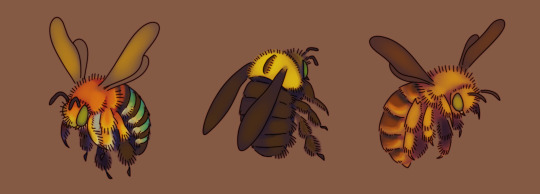
Impressions of a bee. (Native Australian Bees)
I think I want to stylize these further? I think. I'm still considering. I got the watercolour vibe I was after. But I think I was hyper vigilant about making the anatomy of each bee stand out that I kind of lost a lot of the initial shapes I had.
1K notes
·
View notes
Text
minecraft bee :D🌸🐝

#minecraft#bee#artists on tumblr#procreate#fanart#digital artist#queer artist#commissions open#native artist
611 notes
·
View notes
Text


cakes i have made in recent times 🎂💐 1. vanilla bean honey raspberry yogurt cake with greek yogurt honey cream frosting , 2. orange cornmeal cake with lemon-orange curd and a whipped cream frosting .. love making cakes so much if i wasn’t committed to the academic bit i would just be a baker
#first is from yesterday i got the flowers from the farmers market in the morning and there was a native bee in one of them!!#the farmer who sold them to me was like i was picking them this morning and i noticed him in there.. life is so beautiful for real#mine
315 notes
·
View notes
Text
do what you love..love what you do
207 notes
·
View notes
Text
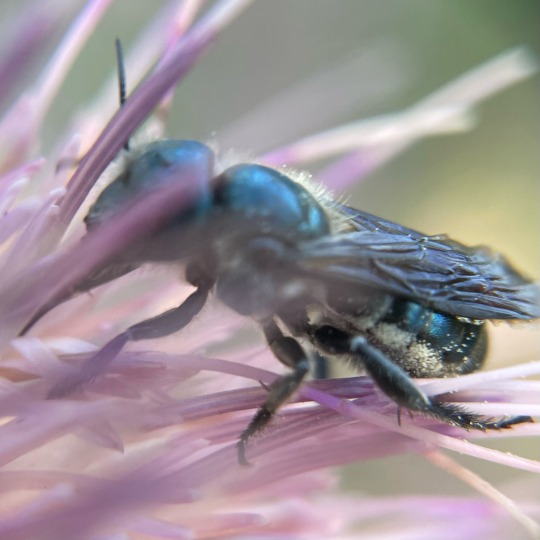


Can’t get enough of these blue lovelies.
#blue mason bee#mason bee#native bee#bee#bugblr#macro photography#my photos#nature#nature photography
9 notes
·
View notes
Note

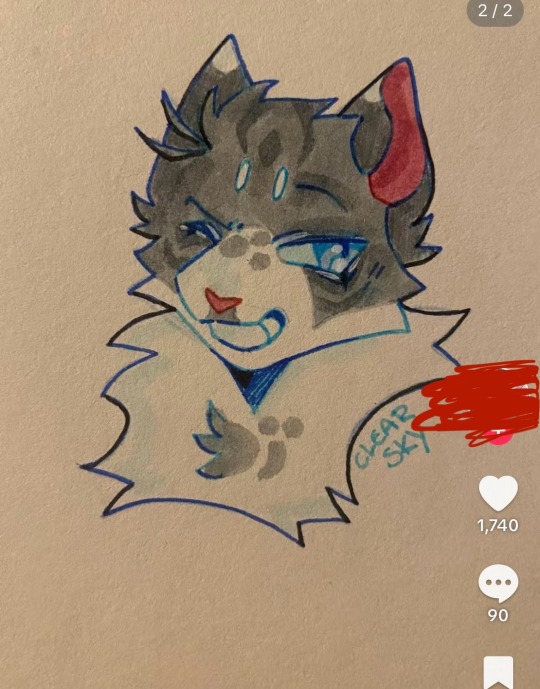
average day in the tiktok warriors fandom
he's. he's literally described on the page as enjoying the feeling of making cats viciously maul each other. He gets "validation" for his feelings constantly through Gray Wing and his other sycophants kissing his ass, and still maliciously and intentionally torments them. He beats women and children for telling him no
What they want is BREEZEPELT. This describes BREEZEPELT. BREEZE. PELT.
The cat who is ACTUALLY reprimanded by authority for being angry all the time?? The one whose dad screeches at him for having basic needs?? A character who is explicitly shown to be manipulated by an evil force because they're the only ones who validate his feelings??
THAT Breezepelt?? Ringing any BELLS?
Lemmie guess. Tiktok probably doesn't like Breezepelt much because if you acknowledge that he's a child abuse victim, you can't keep woobifying Crowfeather into a sad boy. Lol.
#INCREDIBLE briainrot on tiktok#Clear Sky literally has a scene in Book 2 where all his cats gather around and validate him#During that speech where he decides to steal more land by killing more natives#Frost is one of them and then he still shoves Thunder's face into his wound so he ''knows'' why Frost needs to die#Clear Sky is CONSTANTLY getting his toes sucked and having people tell him he's the bees knees#You see he was just slaughtering indigenous people and beating women and children because he's sad :(#How dare you call him a heartless monster he's just angry :(((#(Meanwhile Clear Sky is in the background slobbering over a young woman with traits that remind him of his kid)#Re: the simple truth that people are more interested in sorrowful abusers than messy victims#Because that's what Clear Sky and Crowfeather are. And they will DESPERATELY find ways to woobify them further#so that they can keep ignoring the children they abused.
68 notes
·
View notes
Link

The western bumble bee (Bombus occidentalis), one of the focal species of the conservation strategy, is currently under review for listing under the Endangered Species Act. This specimen was collected on western mountain aster (Symphyotrichum spathulatum) at a site on the Okanogan-Wenatchee National Forest south of Cle Elum and photographed as part of the Pacific Northwest Bumble Bee Atlas. After recording information about the bee it was released, unharmed. (Photo: Ed Lisowski.)
2K notes
·
View notes
Text
As a society we have done thistles so dirty. Not even pollinator-plant zealots recommend planting thistles even though pollinators go absolutely crazy over them.
I saw 2 (two) Great Spangled Fritillaries trying to cram themselves onto the same thistle flower today as well as a thistle plant with multiple American Bumblebees on it. These things are a monarch magnet too.
I know what I'm gonna be gathering seeds from

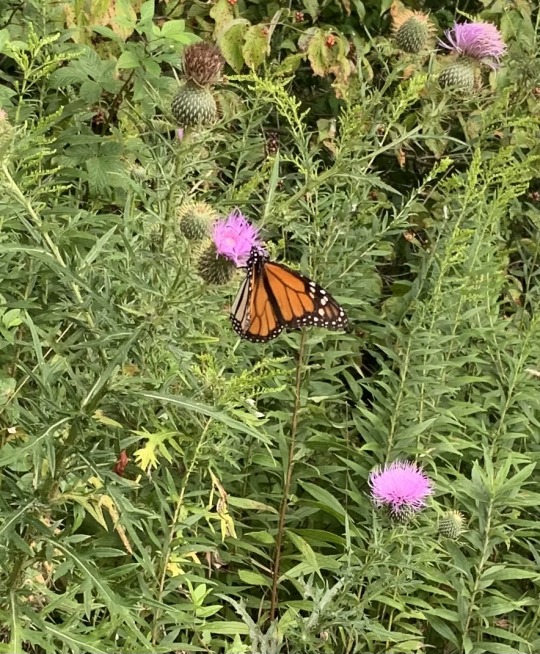
1K notes
·
View notes